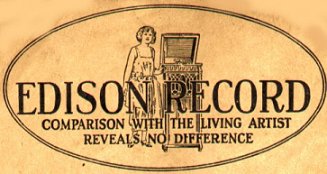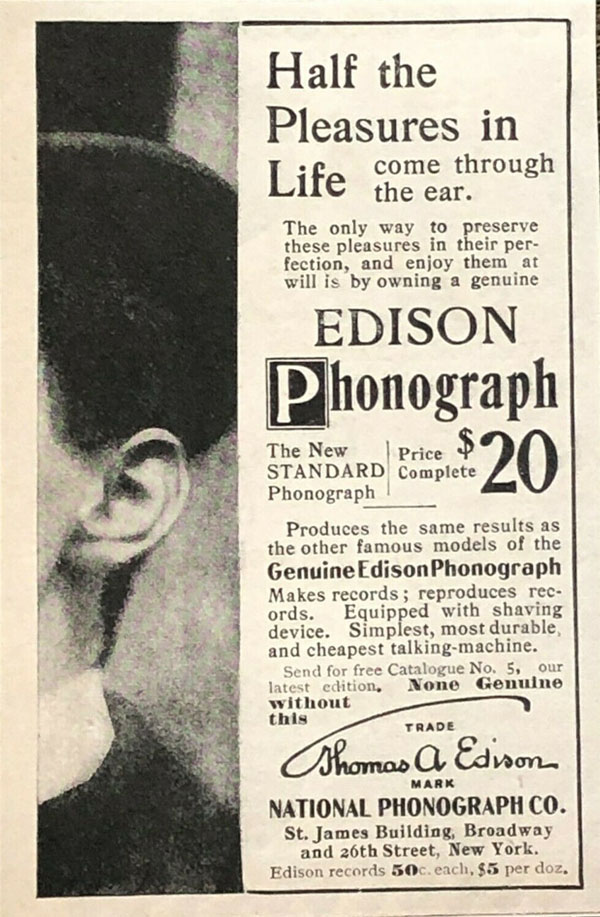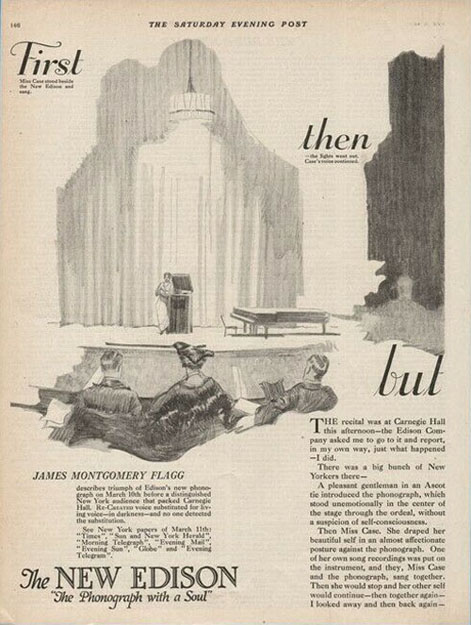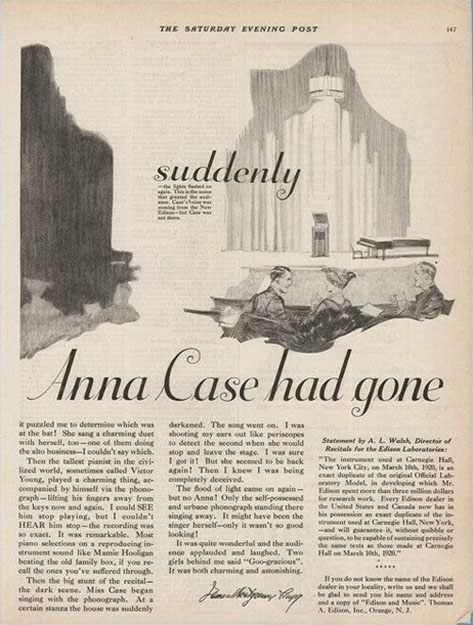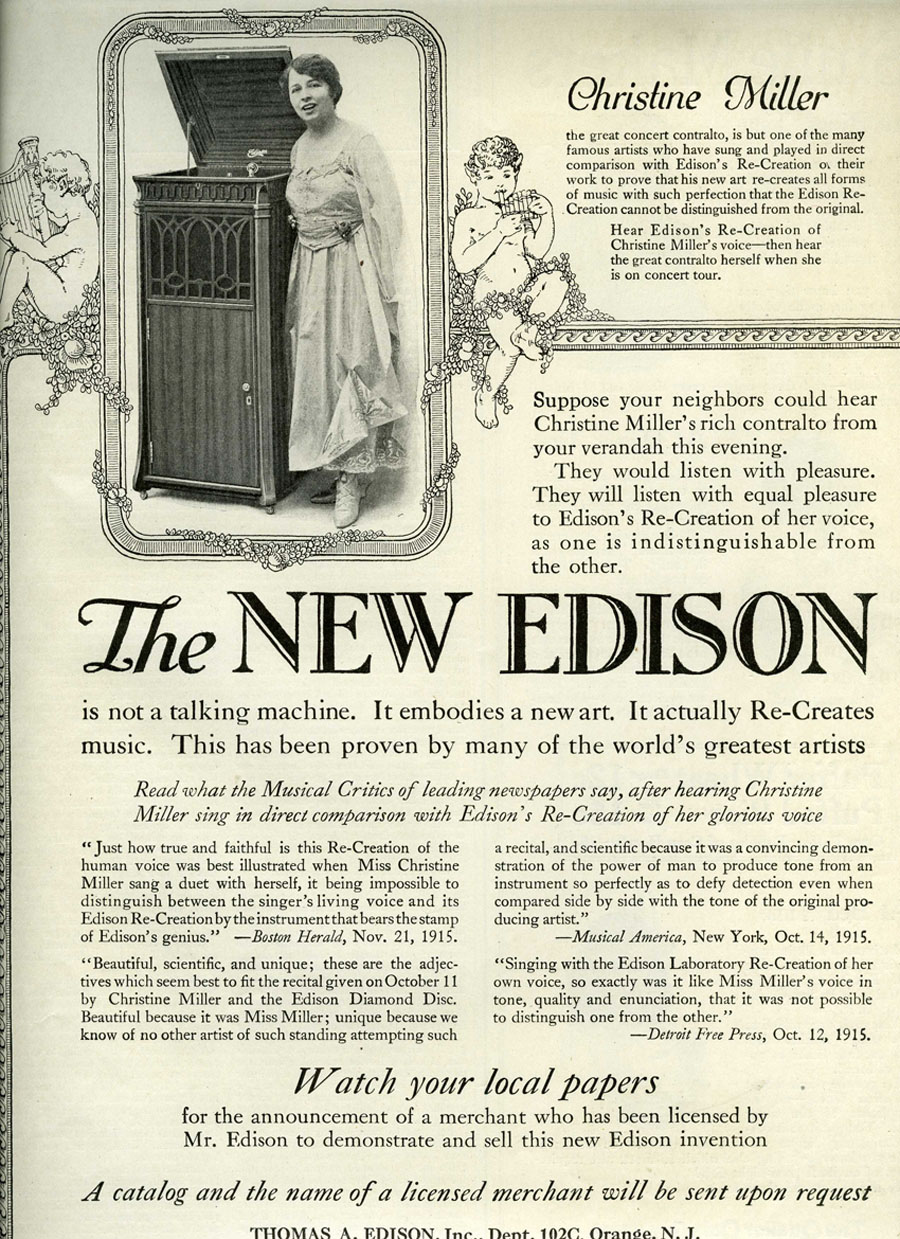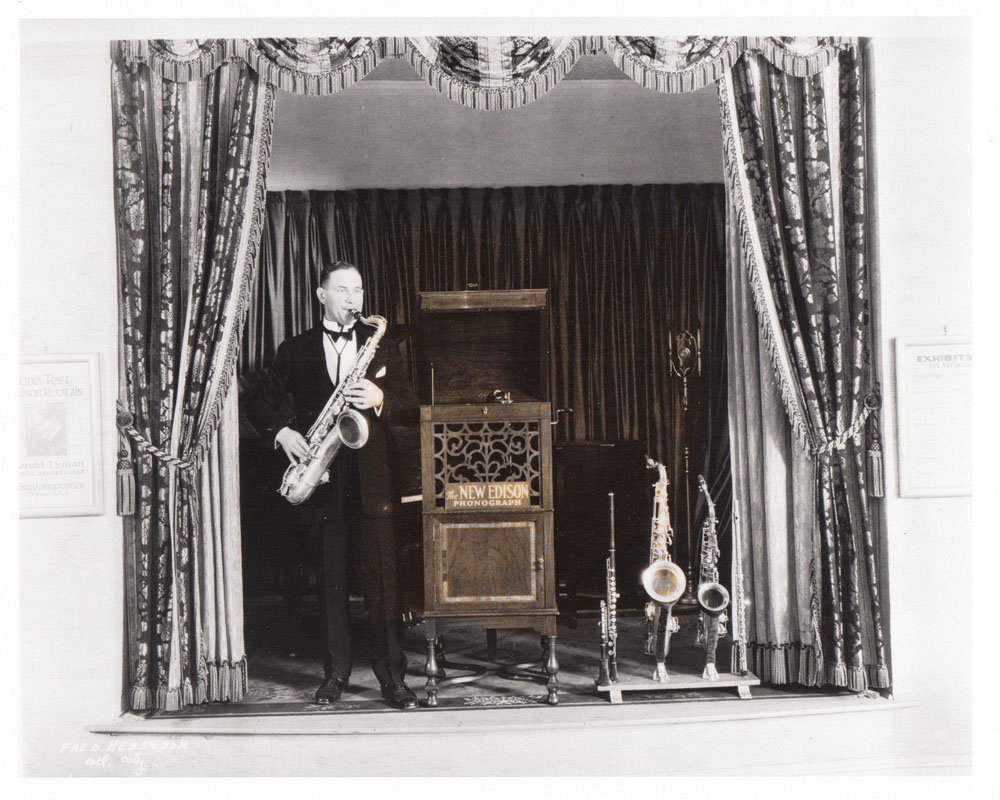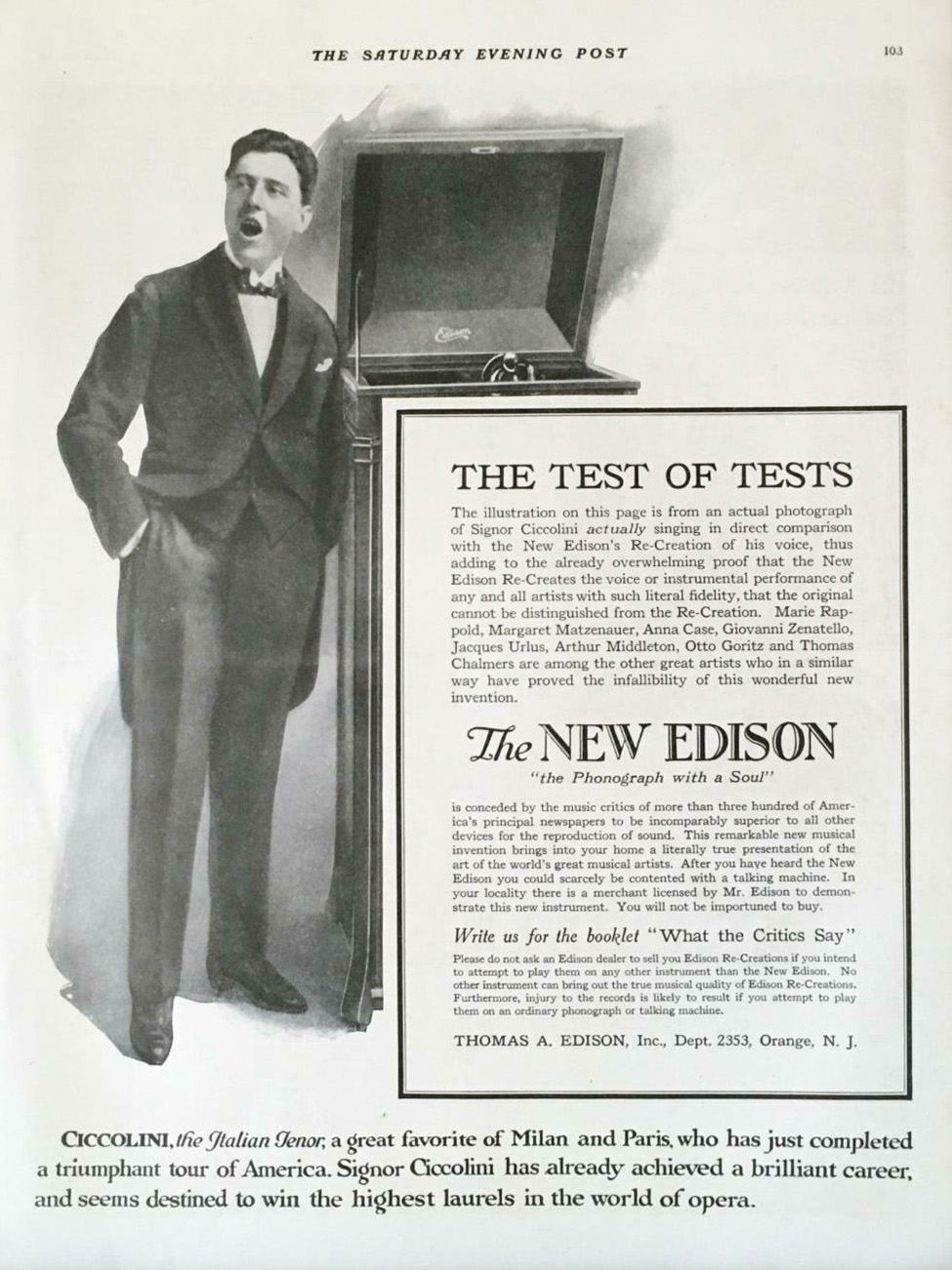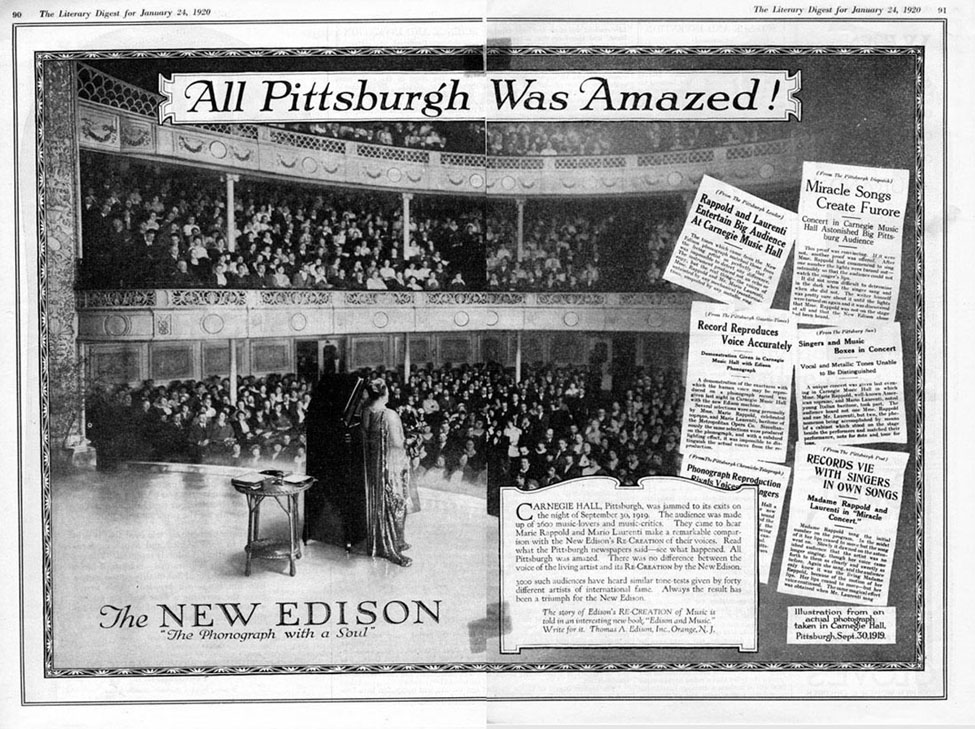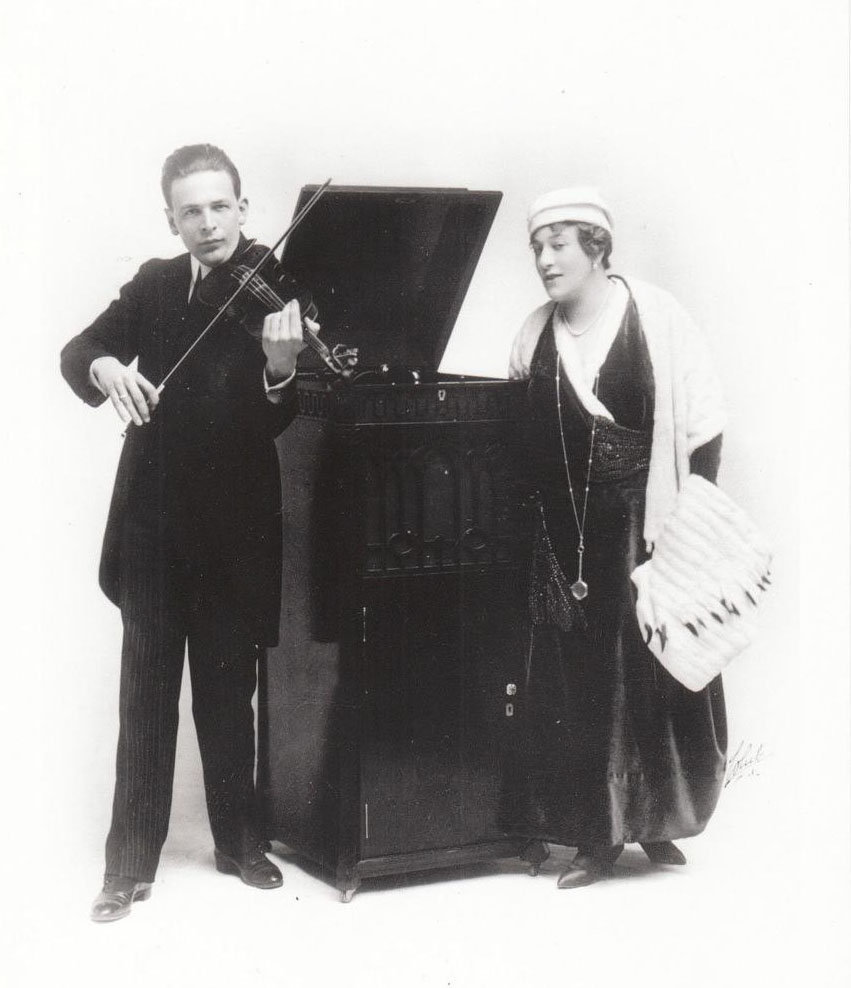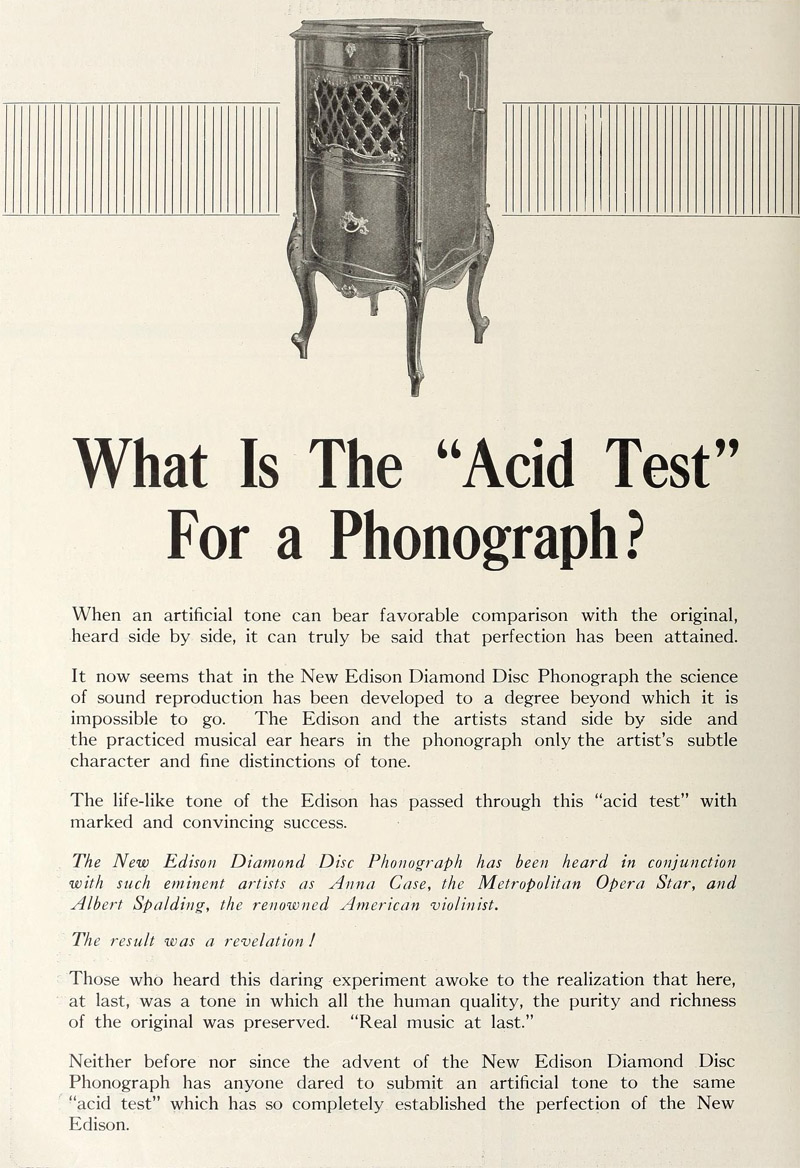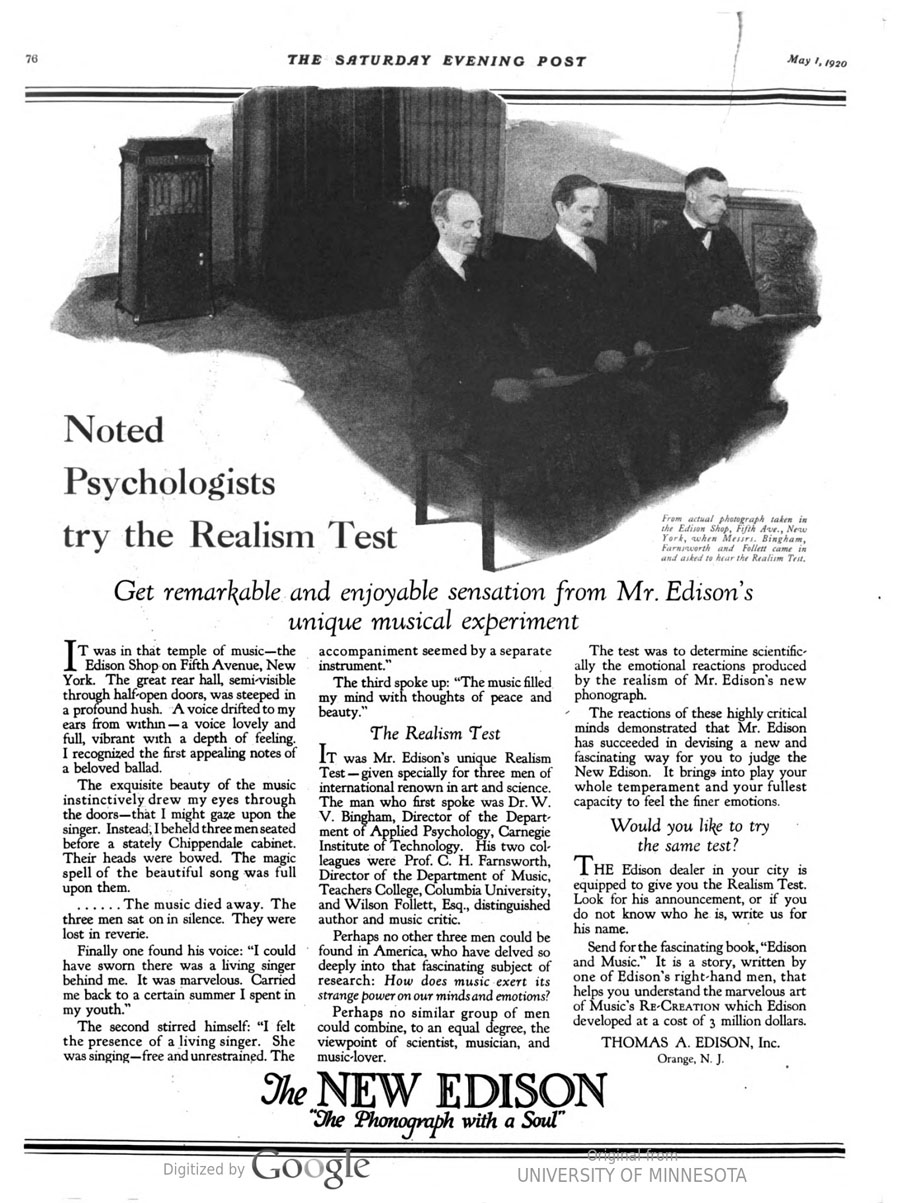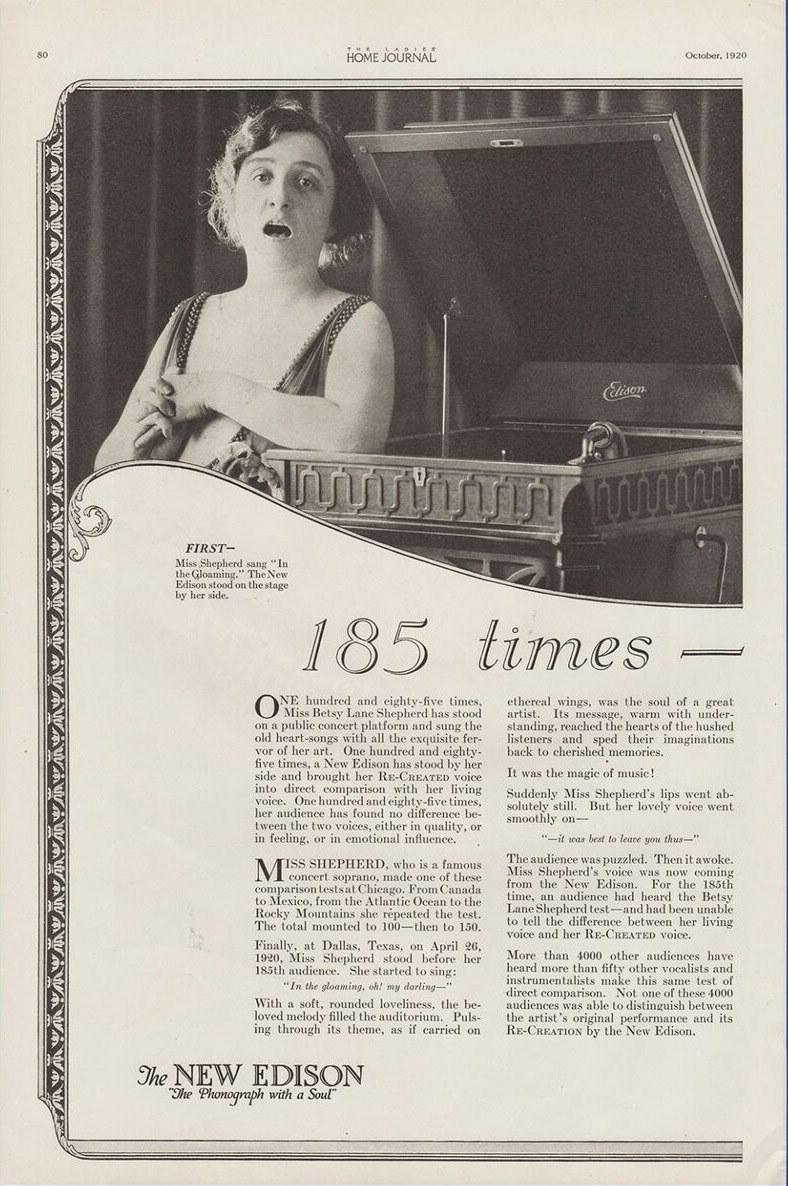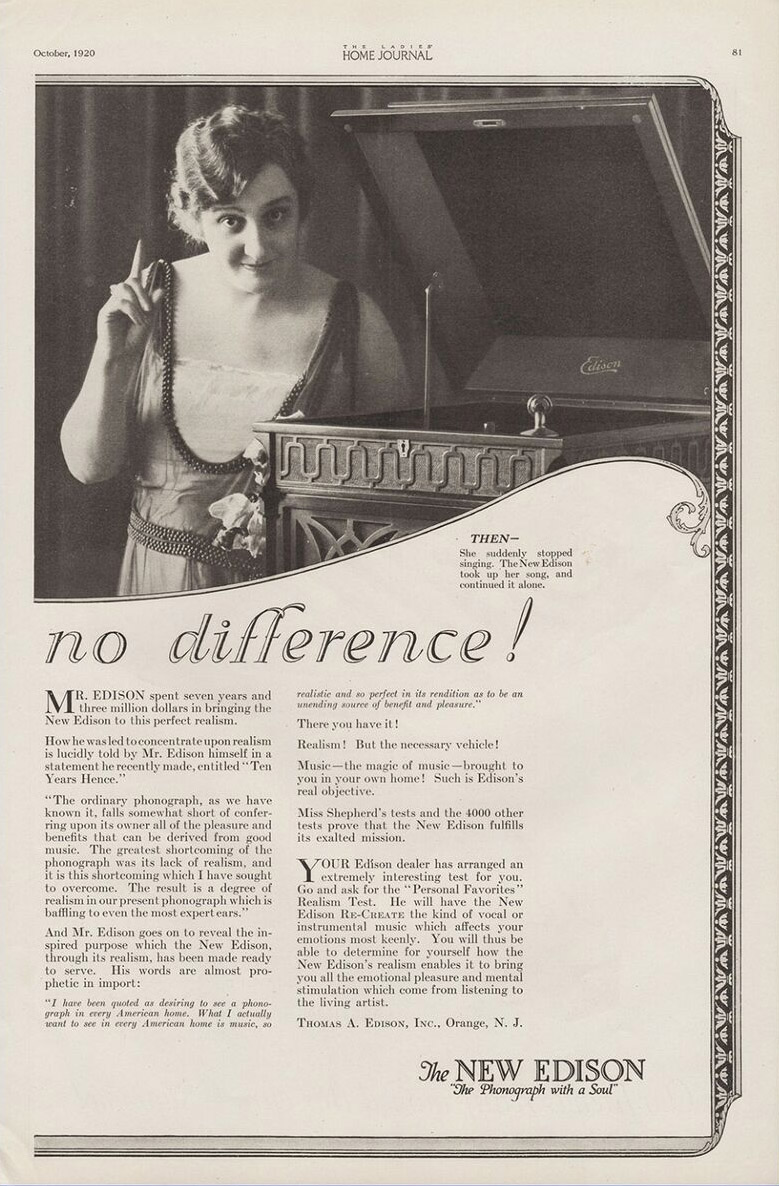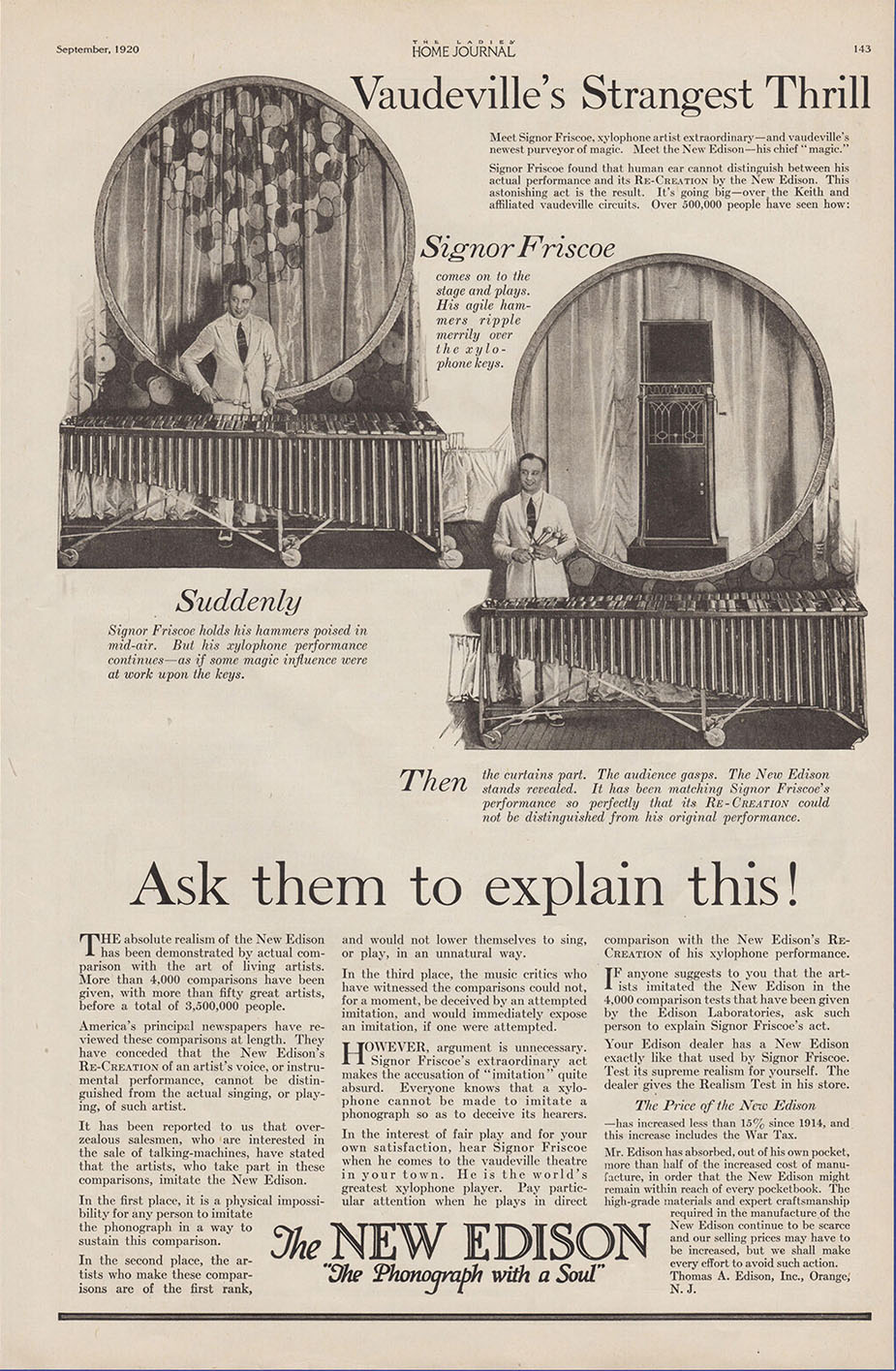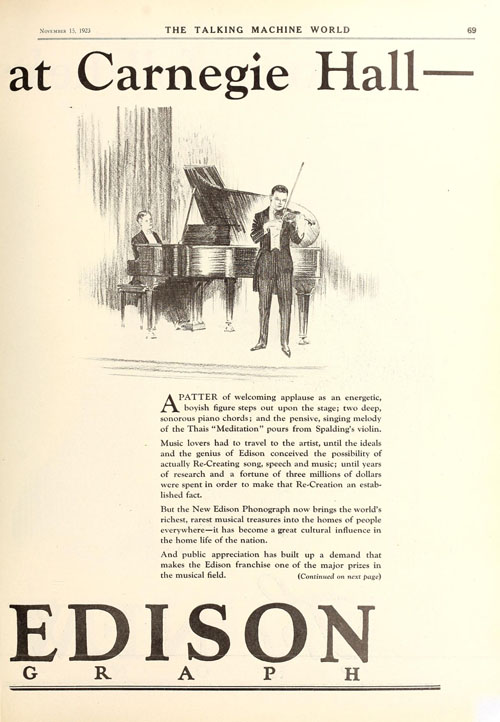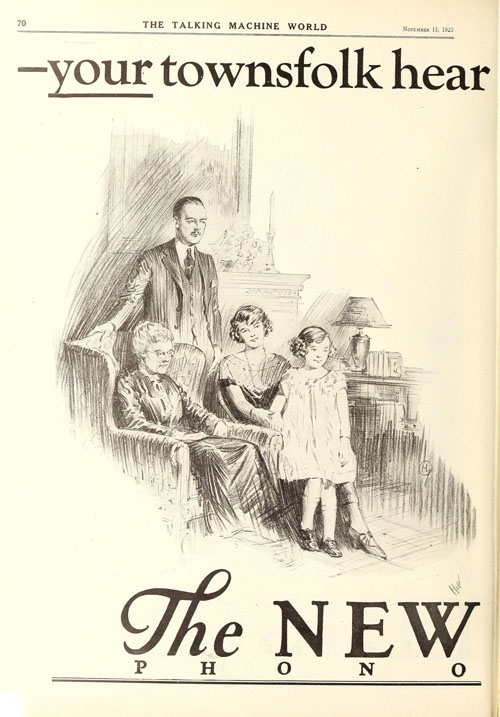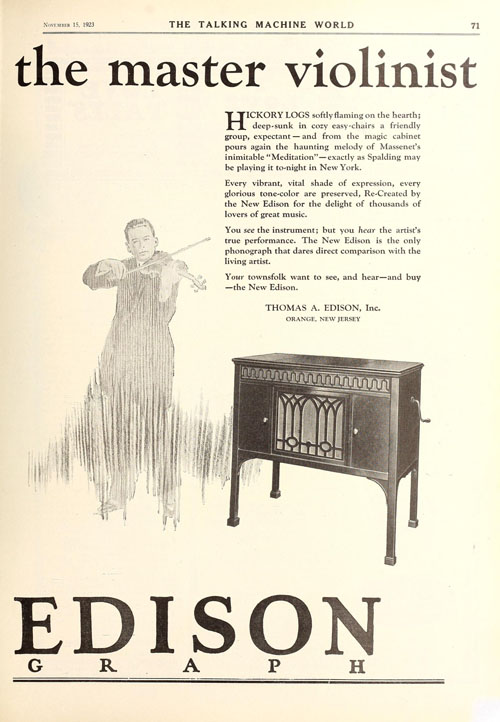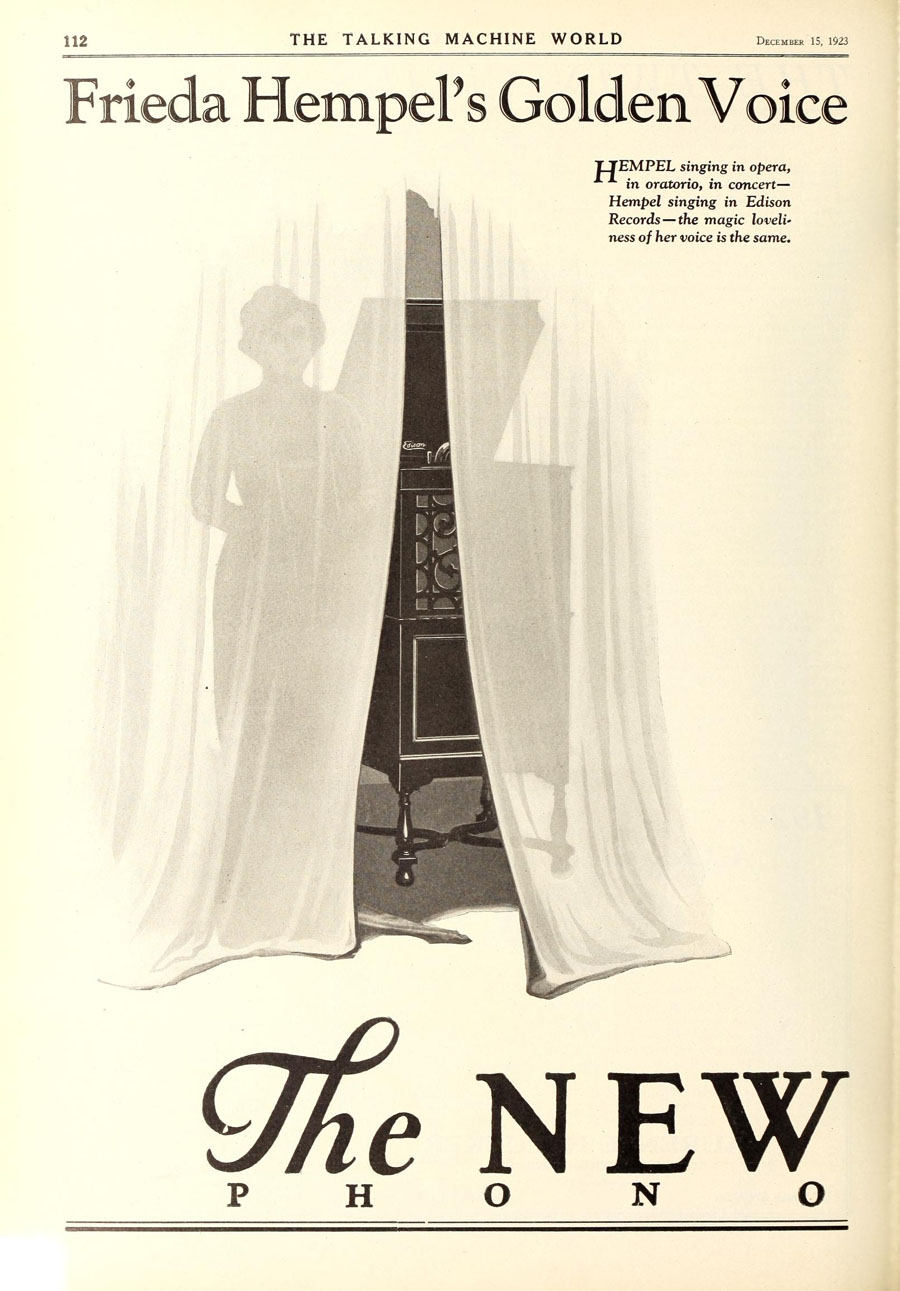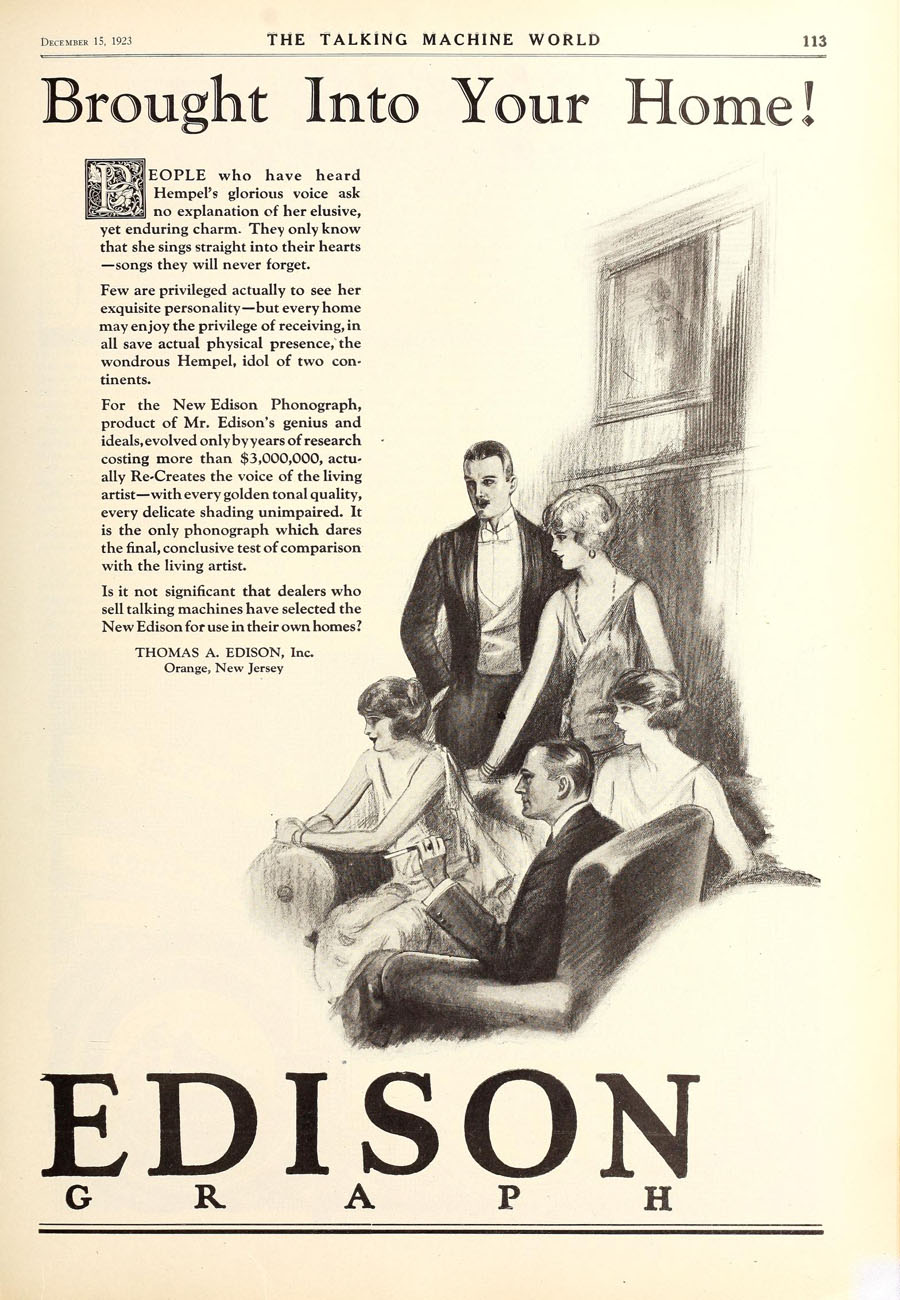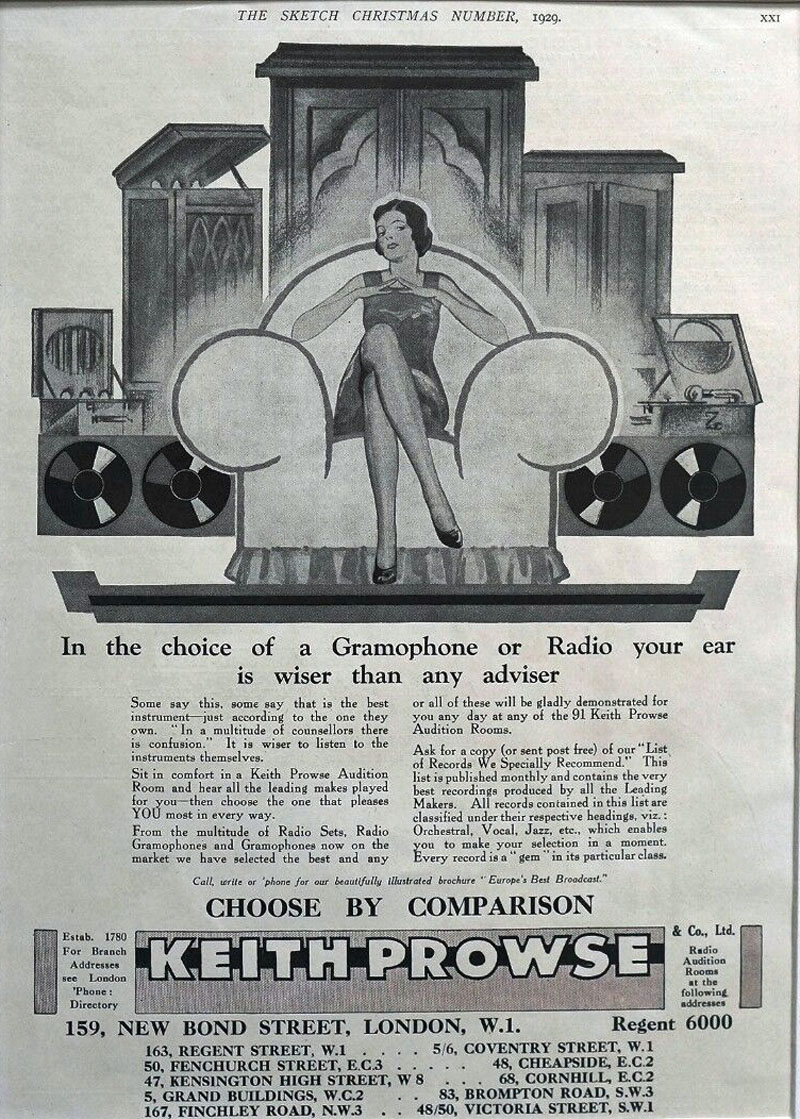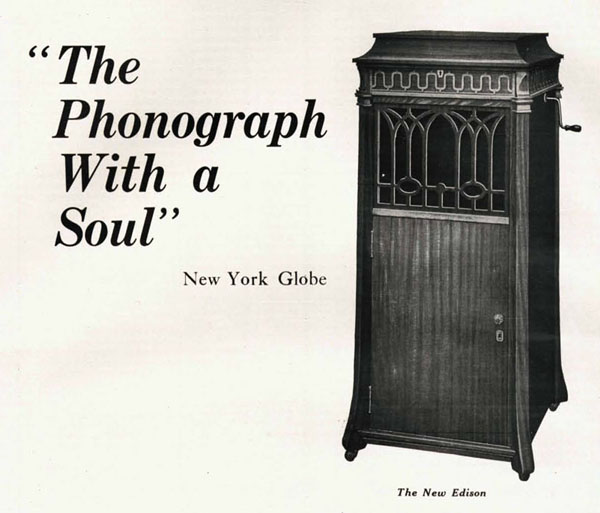Edison Tone Tests
Advertising Edison's Diamond Disc Phonograph
Edison conducted Tone Test ‘recitals’ from 1915 to 1925 to demonstrate that audiences could not tell the difference between his Diamond Disc recordings and the live performances. Edison's entry into the world of disc phonographs was late, but he was determined to prove that his technology was the best.
Edison's ads included several phrases to describe these tests such as "The Test of Tests," "Realism Tests, "The Acid Test," "Comparison Tests" and "Tone Tests."
But in the end it was always a question of whether or not the audience could tell the difference between the artist and the re-created record; between the "life-like tone" and the Re-Creation of music (as distinguished from mere mechanical and approximate reproduction).
And it was "Tone" that seemed a good descriptor for what was being asked regarding the equivalency of live and what was heard from the record. As such, the "Tone Tests" became the defined focus of the Edison recitals.
Listening would be the key to judge the quality of any sounds as an 1899 Edison ad had already emphasized by displaying an ear and then saying that "the only way to preserve these pleasures in their perfection, and enjoy them" is by owning a genune Edison Phonograph."
Munsey's Magazine, February 1899, 2 3/4" x 4"
In the earliest days of phonograph advertising one of the challenges was to get the public to hear their machines. This was addressed in phonograph ads by recommending that consumers simply needed to visit their phonograph store, listen and decide with your own ears. It was the "Hearing is Believing" advertising approach.
The Edison Tone Tests were later version of inviting the public to come listen. This time, however, the venues would be potentially much larger and live artists performed. Also, the public hadn't been invited to simply listen to a record. Instead, they would be asked if they could distinguish between a live performing artist and an Edison record.
FACTOLA: According to audio historian Emily Thompson in an article titled “Machines, Music, and the Quest for Fidelity: Marketing the Edison Phonograph in America, 1877-1925” (Musical Quarterly 79, Spring 1995, pp. 131-171), "between 1915 and 1920 the Edison company sponsored over four thousand tone tests and twenty-five different sets of artists were scheduled to perform more than two thousand tone tests in 1920 alone. The test groups toured towns, large and small, all across America to tout the wonders of the Edison Diamond Disc."
Here is a production by Sound Beat (click LISTEN) which provides a brief summary of an Edison Tone Test.
LISTEN - The Edison Tone Tests produced by SOUND BEAT
Episode Air Date: July 25, 2019
Artist: Marie Rappold Recording
Title: Love's Old Sweet Song
(TRANSCRIPT) - The opera house lights dim, the capacity crowd hushes…Then a voice, a high, bright soprano…yes, there it is…fills the air. But the real fun starts when the singing stops. You see, the year is 1919, and the crowd is taking part in an Edison Tone Test. Before the lights come back up, they’re prompted to guess if what they heard was live, or a diamond disc. Wax cylinders provided mankind the ability to reproduce sound. By 1912, though, Edison had clarity in mind when he developed the Diamond Disc. Grudgingly. Competitors had started producing flat records over a decade earlier, but Edison wasn’t convinced. Like that guy who held onto eight tracks just a bit too long…except he was the one making them! He produced both until 1929. In fact, many of the cylinders produced during this time, like this one, were… dubs from diamond discs. That’s a whole different level of stubborn.
You’ve been listening to Love’s Old Sweet Song recorded by Marie Rappold in 1919.
TONE TEST ADVERTISEMENTS
The following are a selection of Edison Tone Test advertisements from 1915 - 1923.
Anna Case Tone Test, The Saturday Evening Post, 1920 James Montgomery Flagg
Anna Case's Re-Created Voice reviewed by Musical Critics of leading newspapers, August 1916 McClure's (PM-2020)
Harold Lyman making a Tone Test, November 1925 (Courtesy of the US Department of Interior - National Park Service)
Amanda Petrusich author of Do Not Sell at Any Price writes the following about a Tone Test in 1915 that included Mr. Lyman:
On September 17, 1915, Edison Records organized an invitation-only concert in Montclair, New Jersey, booking the contralto Christine Miller, the flautist Harold Lyman, and the violinist Arthur Walsh. It was the first of Edison's so-called Tone Tests, in which someone placed an Edison Diamond Disc phonograph in the center of a stage and cued a 78. (That night, it was Miller singing "O Rest in the Lord," an aria from Felix Mendelssohn's Elijah.) Then Miller (or whomever) would being performing along with the recording. Periodically, the singer or player would stop moving his or her mouth, or lower the blow. Audiences gasped when they realized they couldn't tell the difference: A collective breath, snagged. As Greg Milner clarifies in Perfecting Sound Forever, the singers and musicians likely fudged it a bit, imitating the recording rather than trusting it would reflect the live performance, but even that shift felt profound. "From now on," Milner wrote, "Recordings would not sound like the world; the world would sound like recordings." (1)
In a 1915 advertisement, Edison emphasized that the records used for the Tone Tests were not specially made for any test. These were stock records that could be purchased at any Edison Dealer's store.
Music Trade Review, 1915
"The Test of Tests," The Saturday Evening Post, 1917
The Edison Shop ad, October 1917 New York Tribune (Courtesy of oldapplicanceads.com)
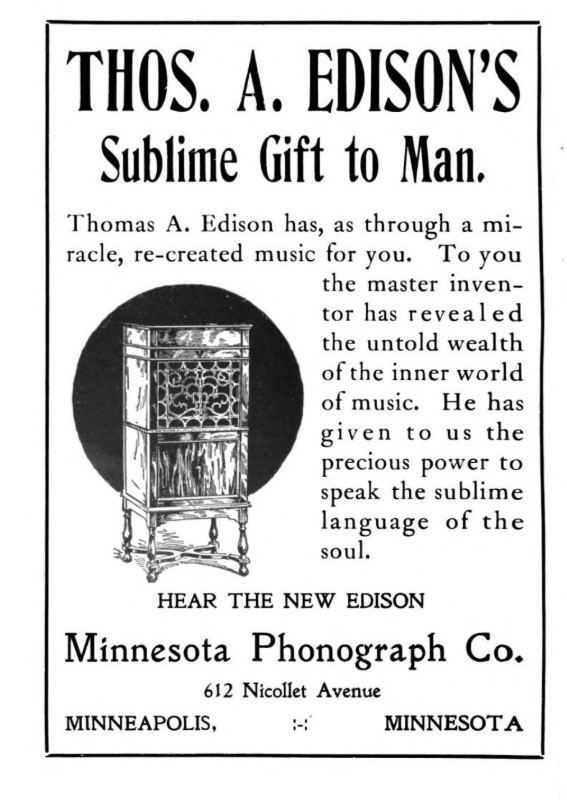
1918
The Literary Digest for January 24, 1920
Violinist Albert Spalding and operatic virtuoso Marie Rappold, Edison Tone Test Artists, 1918 - Promotional photograph
The "Acid Test" - The life-like tone of the Edison has passed with convincing success, The Talking Machine World, August 1915
"185 times -- no difference!" The Ladies' Home Journal, October 1920
"The Realism Test" - The Saturday Evening Post, May 1, 1920
Miss Betsy Lane Shepherd is featured in the October 1920 issue of The Ladies' Home Journal for 185 public performances standing next to the New Edison Phonograph with a Soul and for 185 performances the audiences have "found no difference between the two voices, either in quality, or in feeling, or in emotional influence."185 times -- no difference!
The Ladies' Home Journal, October 1920
"Comparison Tests" - "Ask them to explain this!" The Ladies' Home Journal, November 1920
As seen in the following four page Edison ad from 1923, an artist performing in Carnegie Hall at the same time could also be in homes across America. Edison described his process of delivering "musical treasures" into homes as "actually Re-Creating song, speech and music." The artist Albert Spalding was not literally appearing in homes while he was playing in Carnegie Hall, but according to the ads hear a Spalding record on an Edison Phonograph in the home was "exactly as Spalding may be playing it to-night in New York."
"The Phonograph with a Soul" recreated music "in all save actual physical appearance." The New Edison Phonograph, read the 1923 ad, is "the only phonograph that dares direct comparison with the living artist." "You see the instrument; but you hear the artist's true performance."
The Talking Machine World, November 1923
Likewise, Frieda Hempel's Golden Voice in concert is the "same magic loveliness" brought into the home with an Edison Record.
The Talking Machine World, December 1923
Although Edison's entry into the world of disc phonographs had been late, his Tone Tests provided significant contributions to the overall industry advertising theme to 'listen' and that what they heard could make their own home the "Stage of the World."
Buy a phonograph and records and get the best seat in the house.
Seventh row center.
Forever.
A Question and guest post from the Library of Congress Blog
After learning about Edison's Tone-Tests in this gallery you might be wondering if listeners one hundred years ago really couldn't tell the difference between the live artist and an Edison Record played at one of these demonstrations. The Library of Congress Now See Hear! answers this question "Is It Live or Is It Edison?"
Is It Live or Is It Edison?
May 21, 2015 by Bryan Cornell
Today’s entry is a guest post by Jan McKee, Reference Librarian, Recorded Sound Research Center.
"I have always wondered about the Edison tone tests. Is it really possible that an audience could not tell the difference between an Edison Diamond Disc being played on a phonograph and the live performer singing while standing next to the machine? Were the audiences that naïve and unsophisticated? Were the acoustically recorded Diamond Disc recordings really that good? Were the tests rigged or was something else going on?"
To read her answer, go to this link.
The phonograph industry's shopping advice of listening to help decide what to purchase would continue throughout the evolution of descendent devices playing recorded sound. The following 1929 ad for choosing a Gramophone or Radio summed it up with "Your ear is wiser than any adviser."
Keith Prowse London Audition Rooms, The Sketch, 1929
For more examples of advertisements promoting the fidelity and realism of the phonograph, visit Phonographia's "The Phonograph with a Soul."
